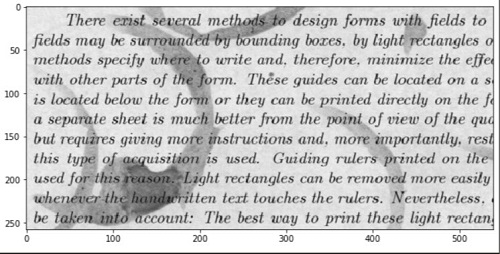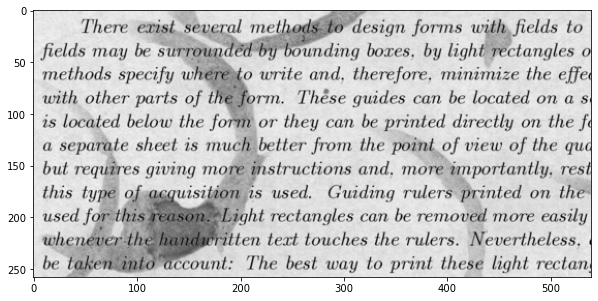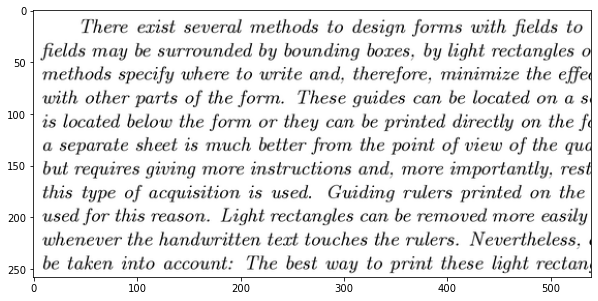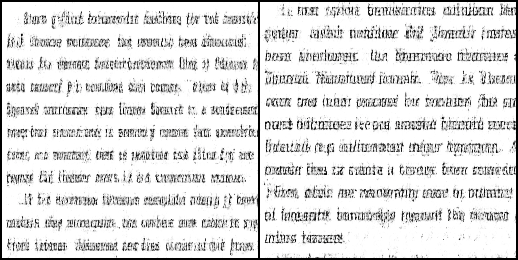使用自编码对文本图像进行去燥
本项目的主要内容是对下面包含文本的图像背景进行去燥处理:

主要的步骤:
- 从kaggle中获取数据
- 建立项目目录
- 准备数据——准备自定义数据集、获取可迭代的数据Loaders
- 建立自编码网络
- 训练数据
- 测试数据
一、从kaggle中获取数据
二、建立项目目录
1 ├───input 2 │ ├───test 3 │ ├───train 4 │ └───train_cleaned 5 ├───models #包含训练好的模型;以及图片 6 │ └───Saved_Images 7 └───src #包含所有的源代码
三、准备数据——准备自定义数据集、获取可迭代的数据Loaders
3.1 包的导入和任务概览
1 import numpy as np 2 import pandas as pd 3 import matplotlib.pyplot as plt 4 import cv2 5 import os 6 import torch 7 import torchvision 8 import glob 9 import torch.nn as nn 10 import torch.optim as optim 11 import torch.nn.functional as F 12 from torchvision.transforms import transforms 13 from torch.utils.data import Dataset, DataLoader 14 from torchvision.utils import save_image
1 # visualize train images 2 def show_image(path): 3 plt.figure(figsize=(10, 7)) 4 img = cv2.imread(path) 5 print(img.shape) 6 plt.imshow(img) 7 plt.show() 8 9 # noisy train image and the corresponding clean train image 10 show_image('../input/train/2.png') 11 show_image('../input/train_cleaned/2.png')
在训练的时候,我们既有训练的噪音文本图也有相对应的干净文本图;
我们的任务就是训练一个深度自编码神经网络实现第二张图像
输出图片:
1)训练噪音图片

2)训练干净图

3.2 准备自定义的Dataset和DataLoaders
加载数据
1 TRAIN_IMAGES = glob.glob('../input/train/*.png') #返回匹配文件路径名 2 TRAIN_CLEAN = glob.glob('../input/train_cleaned/*.png') 3 TEST_IMAGES = glob.glob('../input/test/*.png')
数据大小变换及存储
1 def get_data(path): 2 images = [] 3 for i, image in enumerate(path): 4 image = cv2.imread(image) #读图像 5 image = cv2.resize(image, (256, 256)) 6 image = np.reshape(image, image.shape[0]*image.shape[1]*image.shape[2]) 7 images.append(image) #展平的图像的数组 8 return images #返回全部展平的图像 9 x_train = get_data(TRAIN_IMAGES) #调用函数对所有数据集进行处理 10 y_train = get_data(TRAIN_CLEAN) 11 x_test = get_data(TEST_IMAGES)
输出:
1 print(len(x_train)) 2 print(len(y_train)) 3 print(len(x_test)) 4 print(x_train[1]) 5 6 输出: 7 144 #所有图片的数量 8 144 9 72 10 [231 231 231 ... 220 220 220] #某个展平后的图像
定义超参数和图像变换
1 # constants 2 NUM_EPOCHS = 100 3 LEARNING_RATE = 1e-3 4 BATCH_SIZE = 2
数据转换
1 # define transforms 2 transform = transforms.Compose([ 3 transforms.ToPILImage(), #把Tensor of shape C x H x W or a numpy ndarray of shape H x W x C转换成PIL Image 4 transforms.ToTensor() #a PIL Image or numpy.ndarray to tensor 5 ])
格式很重要;
自定义数据类:
1 # prepare the dataset and the dataloader 2 class ImageData(Dataset): 3 def __init__(self, images, labels=None, transforms=None): 4 self.X = images # 参数的初始化 5 self.y = labels 6 self.transforms = transforms 7 8 def __len__(self): 9 return (len(self.X)) 10 11 def __getitem__(self, i): 12 data = self.X[i][:] #存储所有的数据元素
#把数据转换为numpy的格式 13 data = np.asarray(data).astype(np.uint8).reshape((256, 256, 3)) 14 15 if self.transforms: 16 data = self.transforms(data) 17
#在这里,我们的label也是图像像素值;所以对y进行同样的操作 18 if self.y is not None: #test data不会进入此判断中 19 labels = self.y[i][:] 20 labels = np.asarray(labels).astype(np.uint8).reshape((256, 256, 3)) 21 labels = self.transforms(labels) 22 return (data, labels) 23 else: 24 return data 25
#创建了两个data类; 26 train_data = ImageData(x_train, y_train, transform) 27 test_data = ImageData(x_test, None, transform) 28 29 train_loader = DataLoader(train_data, batch_size=BATCH_SIZE, shuffle=True) 30 test_loader = DataLoader(test_data, batch_size=BATCH_SIZE, shuffle=True)
__getitem__(self, i) 从数据集中返回样本,当我们提供给它一个索引值;
其他辅助函数的编写:
1 # helper functions 2 def create_dir(): 3 image_dir = '../models/Saved_Images' 4 if not os.path.exists(image_dir): 5 os.makedirs(image_dir) 6 7 def save_decoded_image(img, name): 8 img = img.view(img.size(0), 3, 256, 256) 9 save_image(img, name) 10 def get_device(): 11 if torch.cuda.is_available(): 12 device = 'cuda:0' 13 else: 14 device = 'cpu' 15 return device 16 device = get_device() 17 print(device) 18 create_dir()
四、建立自编码网络
1 # the autoencoder network 2 class Autoencoder(nn.Module): 3 def __init__(self): 4 super(Autoencoder, self).__init__() 5 # encoder layers 6 self.enc1 = nn.Conv2d(3, 512, kernel_size=3, padding=1) 7 self.enc2 = nn.Conv2d(512, 256, kernel_size=3, padding=1) 8 self.enc3 = nn.Conv2d(256, 128, kernel_size=3, padding=1) 9 self.enc4 = nn.Conv2d(128, 64, kernel_size=3, padding=1) 10 11 # decoder layers 12 self.dec1 = nn.ConvTranspose2d(64, 64, kernel_size=2, stride=2) 13 self.dec2 = nn.ConvTranspose2d(64, 128, kernel_size=2, stride=2) 14 self.dec3 = nn.ConvTranspose2d(128, 256, kernel_size=2, stride=2) 15 self.dec4 = nn.ConvTranspose2d(256, 512, kernel_size=2, stride=2) 16 self.out = nn.Conv2d(512, 3, kernel_size=3, padding=1) 17 18 self.bn1 = nn.BatchNorm2d(512) 19 self.bn2 = nn.BatchNorm2d(256) 20 self.bn3 = nn.BatchNorm2d(128) 21 self.bn4 = nn.BatchNorm2d(64) 22 self.pool = nn.MaxPool2d(2, 2) 23 def forward(self, x): 24 # encode 25 x = F.relu(self.enc1(x)) 26 x = (self.bn1(x)) 27 x = self.pool(x) 28 x = F.relu(self.enc2(x)) 29 x = (self.bn2(x)) 30 x = self.pool(x) 31 x = F.relu(self.enc3(x)) 32 x = (self.bn3(x)) 33 x = self.pool(x) 34 x = F.relu(self.enc4(x)) 35 x = (self.bn4(x)) 36 x = self.pool(x) # the latent space representation 37 38 # decode 39 x = F.relu(self.dec1(x)) 40 x = (self.bn4(x)) 41 x = F.relu(self.dec2(x)) 42 x = (self.bn3(x)) 43 x = F.relu(self.dec3(x)) 44 x = (self.bn2(x)) 45 x = F.relu(self.dec4(x)) 46 x = (self.bn1(x)) 47 x = torch.sigmoid(self.out(x)) 48 return x 49 net = Autoencoder() 50 print(net) 51 net.to(device)
定义损失函数和优化器
1 # the loss function 2 criterion = nn.MSELoss() 3 # the optimizer 4 optimizer = optim.Adam(net.parameters(), lr=LEARNING_RATE)
五、训练函数
1 # the training function 2 def train(net, train_loader, NUM_EPOCHS): 3 train_loss = [] 4 for epoch in range(NUM_EPOCHS): 5 running_loss = 0.0 #计算每个epoch的损失 6 for data in train_loader: 7 img = data[0] 8 labels = data[1] 9 img = img.to(device) 10 labels = labels.to(device) 11 optimizer.zero_grad() 12 outputs = net(img) 13 loss = criterion(outputs, labels) #计算损失 14 # backpropagation 15 loss.backward() #反向传播 16 # update the parameters 17 optimizer.step() #参数更新 18 running_loss += loss.item() 损失的叠加 19 20 loss = running_loss / len(train_loader) 21 train_loss.append(loss) 22 print(f'Epoch {epoch+1} of {NUM_EPOCHS}, Train Loss: {loss:.5f}') 23 24 if epoch % 10 == 0: 25 save_decoded_image(outputs.cpu().data, name='../models/denoised{epoch}.png') 26 return train_loss
测试函数
1 # the test function 2 def test(net, test_loader): 3 with torch.no_grad(): 4 for i, data in enumerate(test_loader): 5 img = data 6 img = img.to(device) 7 outputs = net(img) 8 save_decoded_image(outputs.cpu().data, name='../models/test_image{i}.png')
六、训练和测试:
1 train_loss = train(net, train_loader, NUM_EPOCHS) 2 test(net, test_loader)
七、损失绘制
1 plt.plot(train_loss) 2 plt.xlabel('Epochs') 3 plt.ylabel('Loss') 4 plt.savefig('../models/loss_plot.png') 5 plt.show()

八、测试重构的图像

在测试数据集上,效果不是很好;
在消除背景噪音的同时,文字似乎变得也不可读;
似乎需要加一个惩罚项来进行优化;


